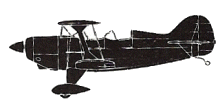
ASN Wikibase Occurrence # 187293
This information is added by users of ASN. Neither ASN nor the Flight Safety Foundation are responsible for the completeness or correctness of this information.
If you feel this information is incomplete or incorrect, you can submit corrected information.
| Date: | Saturday 14 May 2016 |
| Time: | 16:47 |
| Type: |  Pitts S-2SW |
| Owner/operator: | Private |
| Registration: | N24CD |
| MSN: | 001CGC |
| Year of manufacture: | 2014 |
| Total airframe hrs: | 159 hours |
| Engine model: | Lycoming AEIO-540-FBAE |
| Fatalities: | Fatalities: 1 / Occupants: 1 |
| Aircraft damage: | Destroyed |
| Category: | Accident |
| Location: | Dekalb-Peachtree Airport (KPDK), Atlanta, GA -
 United States of America United States of America
|
| Phase: | Manoeuvring (airshow, firefighting, ag.ops.) |
| Nature: | Demo/Airshow/Display |
| Departure airport: | Atlanta, GA (PDK) |
| Atlanta, GA (PDK) | |
| Investigating agency: | NTSB |
| Confidence Rating: |
The pilot of the Pitts was performing air show maneuvers as part of a flight of two with the other show pilot flying an MX2 airplane. After uneventful departures and performance of a low altitude pass, both pilots initiated a pull-up into a half Cuban-8, with the intention of simultaneously positioning the airplanes on 45º down angles toward show center in preparation for another low altitude pass. The MX2 pilot stated that he rolled out near the show line, and he expected the Pitts to be established over the show line and to his left. Instead, the Pitts was still above him on the 45º down line and well to his right. It is apparent that the Pitts pilot put himself out of position by not adjusting to the crosswind conditions or he did not correctly identify the show line. The evidence indicated that he never lost control of the airplane.
An examination of several spectator videos indicated that, during the half Cuban-8 maneuver, the Pitts pulled over the top, rolled 1 1/2 times to the left, and was then established upright on the 45º down line. The extra roll during the half Cuban-8 was not normal and put him further out of position. The wings of the Pitts then rocked back and forth, first to the left about 45º and then to the right approaching 90º. The airplane remained in a descending right bank and then appeared to level off immediately before ground impact. After ground impact, the airplane caught fire and burned.
Postaccident examination of the wreckage did not reveal evidence of any preimpact mechanical malfunctions or anomalies. The wind at the time of the accident was about perpendicular to the show line, blowing away from the spectators, with gusts up to 25 knots. When asked about the wind conditions, the MX2 pilot acknowledged that they were significant; however, he added that airshow pilots know how to adjust for wind and that the wind did not adversely affect their maneuvering.
Toxicology detected the potentially-impairing medications diphenhydramine and dextromethorphan in urine but not the blood. Since these medications were not detected in the blood, it is unlikely that the pilot was feeling any significant effects from these medications at the time of the accident. Additionally, although pseudoephedrine and ephedrine were detected in urine and blood, these compounds are generally not considered to be impairing and are unlikely to have contributed to the crash. However, these medications are found in combination in many over-the-counter cough and cold medications used to help decrease head congestion. Head congestion can degrade the vestibular system (the body's balance and orientation system) and impair a pilot's ability to control an airplane during flight. The investigation was unable to determine if the pilot's underlying medical condition at the time of the crash affected his ability to safely control the airplane during low altitude acrobatic flight.
Probable Cause: The pilot's failure to maintain proper positioning during performance of an aerobatic maneuver and his subsequent failure to discontinue maneuvering when unable to reestablish proper positioning during a steep descent toward the ground.
Accident investigation:
 |
|
Sources:
NTSB
FAA register: http://registry.faa.gov/aircraftinquiry/NNum_Results.aspx?NNumbertxt=24CD
Location
Images:

Photo: NTSB
Media:
Revision history:
| Date/time | Contributor | Updates |
|---|---|---|
| 14-May-2016 23:05 | Geno | Added |
| 14-May-2016 23:20 | Geno | Updated [Aircraft type, Source] |
| 14-May-2016 23:42 | Geno | Updated [Total fatalities] |
| 15-May-2016 00:27 | Geno | Updated [Aircraft type, Registration, Cn, Operator, Source, Narrative] |
| 15-May-2016 06:10 | Iceman 29 | Updated [Embed code] |
| 15-May-2016 16:38 | harro | Updated [Embed code] |
| 25-May-2016 16:41 | Anon. | Updated [Source] |
| 21-Dec-2016 19:30 | ASN Update Bot | Updated [Time, Damage, Category, Investigating agency] |
| 22-Apr-2018 19:30 | ASN Update Bot | Updated [Operator, Departure airport, Destination airport, Source, Embed code, Narrative] |
| 22-Apr-2018 19:59 | harro | Updated [Source, Embed code, Narrative, Photo, ] |
Corrections or additions? ... Edit this accident description
The Aviation Safety Network is an exclusive service provided by:


 ©2024 Flight Safety Foundation
©2024 Flight Safety Foundation